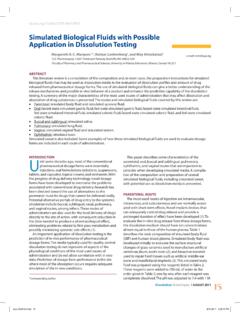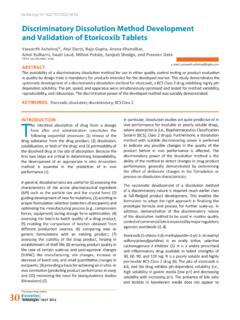Transcription of Biorelevant Dissolution Media Simulating the Proximal ...
1 Biorelevant Dissolution Media Simulating the Proximal Human Gastrointestinal Tract: An Update e-mail: Ekarat Jantratid and Jennifer Dressman1. Institute of Pharmaceutical Technology, Johann Wolfgang Goethe University, Max-von-Laue-Str. 9, 60438 Frankfurt am Main, Germany INTRODUCTION enabling the active pharmaceutical ingredient (API) to A. s part of a drive to develop predictive in vitro dissolve in a timely manner before it reaches the models to forecast the in vivo performance of drugs absorptive sites in the small intestine.
2 Under fasting and drug products, two Biorelevant Dissolution conditions, it is well known that the pH in a healthy human Media Simulating conditions in the Proximal small stomach is acidic, ranging between 1 and 3 (2, 6). intestine, Fasted-State Simulated Intestinal Fluid (FaSSIF) For poorly soluble weak bases, the pH conditions for and Fed-State Simulated Intestinal Fluid (FeSSIF), were Dissolution are the most favorable in a fasted, healthy proposed in 1998 (1). Although these Media have been stomach.
3 Compared with simple aqueous buffers like proved useful in terms of in vivo predictions, there is Simulated Gastric Fluid without pepsin (SGFsp), gastric room for improvement. One aspect that might lead to fluids have a low surface tension in addition to a low suboptimal predictions is that some parameters in FaSSIF pH (7). A medium representing the fasted conditions in a and FeSSIF ( , buffer capacity) were chosen on the basis human stomach, so-called Fasted-State Simulated Gastric of canine, rather than human data (1).
4 Additionally, since Fluid (FaSSGF), was proposed by Vertzoni et al. in 2005 (5). the first set of Biorelevant Media were developed, there The medium was designed to embrace the important have been several studies of the relevant parameters in aspects of human basal gastric juice plus a glass of water humans (2, 3). Of particular note is that the bile salt normally given with a dosage form. The composition and concentrations reported in more recent studies tend to be properties of FaSSGF are shown in Table 1.
5 Lower than in older reports, most likely as a result of more With respect to the applications of FaSSGF, the medium specific analytical techniques. Moreover, the previous is able to predict the solubility of poorly soluble drugs in versions of the Biorelevant Media do not reflect the the fasted stomach rather well (5, 8). Figure 1 compares the lipolysis products of meal digestion that are known to solubility of ketoconazole in human gastric aspirates with enhance the solubility and Dissolution of poorly soluble that in FaSSGF and other Media .
6 The solubility results in lipophilic drugs (3). FaSSGF were most similar to those in the aspirates. The Biorelevant Dissolution Media have been updated In the postprandial state, the stomach environment recently to bring the composition and characteristics varies over the course of gastric residence of the meal (2). closer to those of aspirates collected from the human gastrointestinal (GI) tract (4). Together with the medium Simulating the preprandial gastric conditions proposed by Table 1. Composition of the Medium to Simulate the Fasted- Vertzoni et al.
7 In 2005 (5), a core group of four Biorelevant State Stomach: Fasted-State Simulated Gastric Fluid (FaSSGF). Media Simulating both stomach and Proximal small intestine of humans in the pre- and postprandial states Composition has been established (4). These Media can be used to Sodium taurocholate ( M) 80. investigate the release characteristics of drugs and drug products in the stomach and small intestine, particularly in Lecithin ( M) 20. terms of food effects. This article summarizes the Media Pepsin (mg/mL) composition and their important characteristics.
8 In addition, examples of applications of the in vivo Sodium chloride (mM) predictiveness of these Media are presented. Hydrochloric acid pH Biorelevant Media Simulating THE Properties ENVIRONMENT IN THE STOMACH pH The stomach is the port of entry into the GI tract for orally administered drug products. It is here that Osmolality (mOsm/kg) immediate-release (IR) dosage forms should disintegrate, Buffer capacity (mmol/L/pH) . 1. Surface tension (mN/m) Corresponding author. Dissolution Technologies | AUGUST 2009.
9 21. 21 8/25/2009 5:54:15 PM. Table 2. Composition of the Media to Simulate the Fed-State Stomach, Including Fed-State Simulated Gastric Fluid (FeSSGF). Middle Composition Early (FeSSGF) Late Sodium chloride (mM) 148 Acetic acid (mM) . Sodium acetate (mM) . Ortho-phosphoric acid (mM) Sodium dihydrogen phosphate (mM) 32. Milk/buffer 1:0 1:1 1:3. Hydrochloric acid/sodium hydroxide pH pH 5 pH 3. Figure 1. Mean + SD (n=3) solubility data of ketoconazole in human gastric fluid (HGF), in canine gastric fluid (CGF), in Fasted-State Simulated Gastric Fluid (FaSSGF), and in HCl solutions with initial pH values , , and Properties pHeq is the pH of the medium at equilibrium.
10 (Reproduced with permission from ref 8. Copyright 2007 Elsevier.) pH 5 3. Osmolality (mOsm/kg) 559 400 300. Buffer capacity (mmol/L/pH) 25 25. Nevertheless, it is desirable to have a global medium reflecting the changes in the stomach after meal intake to Surface tension (mN/m) make an estimate of food effects on drug Dissolution and release. Milk (full-fat [ ], long-life, UHT-treated) has been considered as a good starting point for medium The composition of the updated FaSSIF, so-called design because its ratio of carbohydrate/protein/fat is FaSSIF-V2, was changed slightly to more closely reflect the similar to that observed in the stomach after in vivo data, while the buffer has been changed from administration of meals ( , those recommended by phosphate to maleate for practical reasons (4).)







